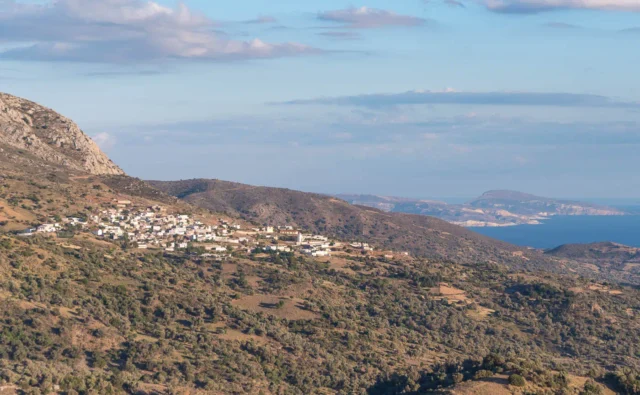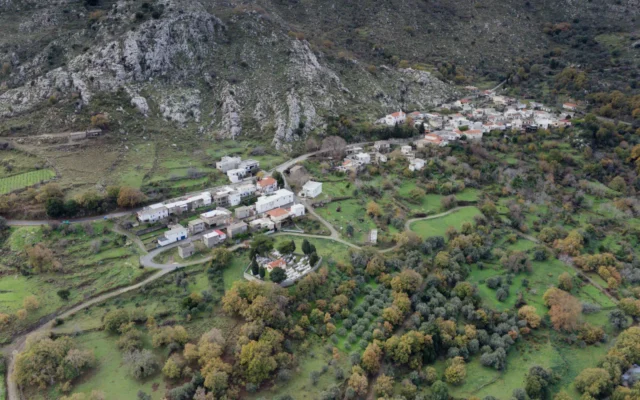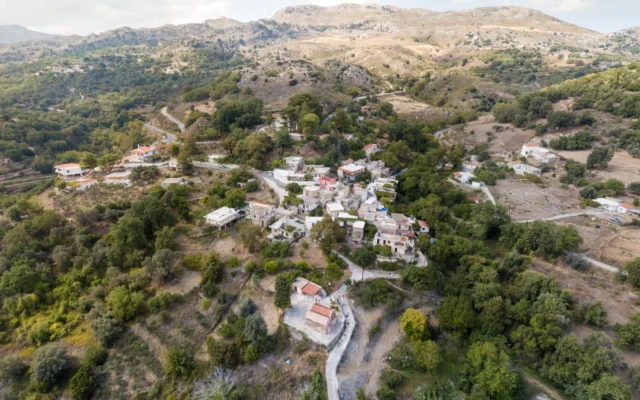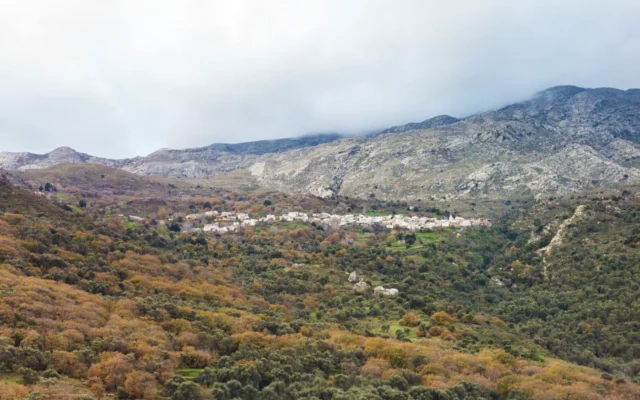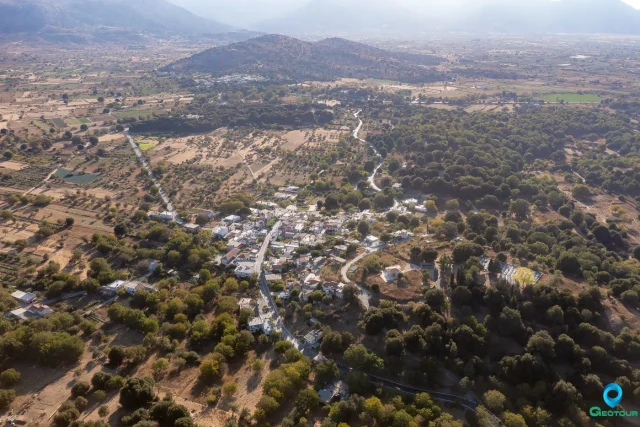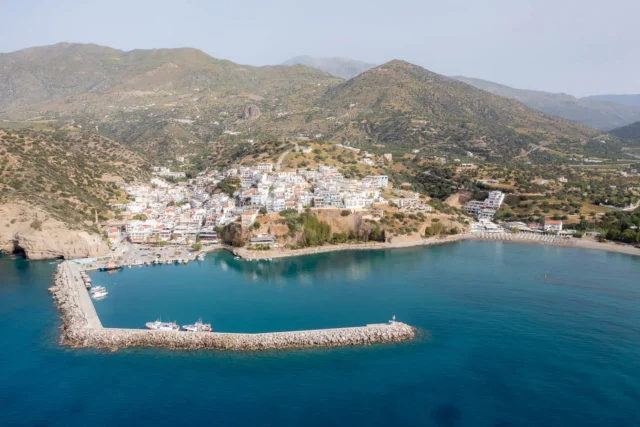438
listings found
Categories
Active filters:
Limnes, Agios Nikolaos
Limnes is a settlement located in the Lasithi regional unit on the island of Crete, Greece. It belongs to the Municipality of Agios Nikolaos
Vrysses, Agios Nikolaos
Vrysses is a settlement located in the Lasithi regional unit on the island of Crete, Greece. It belongs to the Municipality of Agios Nikolaos
Kouroutes, Amari
Kouroutes is a settlement located in the Rethymno regional unit on the island of Crete, Greece. It belongs to the Municipality of Amari
Agia Paraskevi, Amari
Agia Paraskevi is a village in the Amari Municipality of Rethymno, Crete, situated 60 km southeast of Rethymno at 160m altitude. First noted in Venetian records (1577), it was known as S(an)ta Venerand. By 1583, it had 95 inhabitants. The village is home to the 15th-century Byzantine church of Agia Paraskevi, after which it is named, and the Church of the Dormition of the Virgin Mary (1516) with 16th-century frescoes. During WWII, it served as a refuge for resistance fighters involved in the kidnapping of General Kreipe. Noteworthy figures Stylianos and Michalis Pattakos were born here. Primarily agricultural, the village has three churches, including Agios Stylianos. Population has varied, with 124 residents in 2011 and 78 in 2021.
Apodoulou, Amari
A traditional settlement in the Amari region, located in the southern foothills of Mount Psiloritis at an altitude of 450 meters, with views of the Libyan Sea. The name "Apodoulou" is linked to "freedman." Historically referenced since 1577 and a site of conflict during the Cretan Revolution, its landmarks include the mansion of Kallitsa Psaroudaki and a significant Minoan old-palace archaeological site. The local economy is based on agriculture, producing olive oil, wine, and honey.
Vrysses, Amari
Vrysses is a settlement located in the Rethymno regional unit on the island of Crete, Greece. It belongs to the Municipality of Amari
Elenes, Amari
Elenes, situated in Crete's Amari Valley, 37km southeast of Rethymno, is a village with a rich history dating back to Minoan times, as evidenced by archaeological findings. The village, first noted in 1577 as Selenes, features significant Byzantine-era monuments like Agios Nikolaos church with 13th-century frescoes. Historical records show population fluctuations, with current inhabitants engaged in agriculture, maintaining the village's traditional character. The name likely derives from churches dedicated to Agia Eleni. Elenes has seen various administrative changes, now part of Amari Municipality since 2011.
Agios Ioannis, Amari
In Amari, Rethymno, 56km from Rethymno city (370m alt.), near Platy & Xife rivers crossed by old bridges like Manouras (Egyptian era, preserved). Venetian records include Barozzi (1577, S. Z(uann)e Chiliaru) & Kastrofylakas (1583, S. Giovanni Ghliafu). Kartsali has unexcavated Minoan Megaron remnants; Aigianniiotiki korifi features varied period sherds and possible 5th C. basilica ruins. The cemetery Church of Agios Ioannis, its namesake, shows 14th & early 15th C. frescoes (Nativity of John the Forerunner), suggesting a c.1285 monastery katholikon. The parish church Agioi Tesseres dates to the late 19th C. A primary school operated from 1899-1986. The village festival is on August 29th. Noted native: Emmanouil Papadogiannis, Greek Minister (1948-1950). It has been a community seat since 1925.
Ano Meros, Amari
Ano Meros is a settlement located in the Rethymno regional unit on the island of Crete, Greece. It belongs to the Municipality of Amari
Drygies, Amari
Drygies, a small village in the Amari Municipality of Rethymno, Crete, has historical mentions dating back to Francesco Barozzi in 1577. 1 Venetian censuses of 1583 recorded its inhabitants and corvée labor. The village was later noted in the 1834 Egyptian census and the 1881 Greek census. Part of the Ano Meros community for a significant period, Drygies faced destruction by German forces in 1944 following the Kreipe abduction, though villagers evacuated beforehand. The village church is dedicated to the Annunciation. Nearby features include the scenic Smiliano Gorge with waterfalls, the natural beauty of Platys Potamos, scattered chapels, and an ancient olive grove with uniquely shaped trees, near which lies the Byzantine Chapel of Agios Nikolaos with unrestored frescoes. Population figures show a decline from 92 in 1900 to 26 in 2011.
Lampiotes, Amari
Lampiotes is a settlement located in the Rethymno regional unit on the island of Crete, Greece. It belongs to the Municipality of Amari
Mesonisia, Amari
Mesonisia is a settlement located in the Rethymno regional unit on the island of Crete, Greece. It belongs to the Municipality of Amari
Mesa Lasithi, Lasithi plateau
A village in the Lasithi regional unit of Crete, situated on the eastern side of the Lasithi Plateau at an altitude of 850 meters. It serves as the seat of a community including Mesa Lasithaki, Nikiforidon, and Smailiano. The area has been inhabited since the Minoan period, with archaeological remains found at Armi and Agioi Apostoloi. During the Venetian period, its population derived from refugees from Chandax and settlers from Nafplio and Monemvasia, with hamlets ("metochia") documented in the 1583 Kastrophylacas and 1630 Basilicata censuses. Under Ottoman rule, after the 1648 conquest, it became the capital of the Lasithi province by 1700. The region saw resistance from "haïnes" like Captain Kazanis and significant destruction in 1823 by Hassan Pasha and during the 1867 Battle of Lasithi Plateau. Landmarks include the main church, Evangelistria tis Theotokou, Venetian Cisterns at "Katelianes Sterna," and traditional stone architecture.
Kroustas, Agios Nikolaos
Kroustas is a settlement located in the Lasithi regional unit on the island of Crete, Greece. It belongs to the Municipality of Agios Nikolaos
Vizari, Amari
Vizarion is a settlement located in the Rethymno regional unit on the island of Crete, Greece. It belongs to the Municipality of Amari
Livadia, Mylopotamos
Livadia is a settlement located in the Rethymno regional unit on the island of Crete, Greece. It belongs to the Municipality of Mylopotamos.
Agia Galini, Agios Vassilios
Agia Galini is a settlement located in the Rethymno regional unit on the island of Crete, Greece. It belongs to the Municipality of Agios Vassilios
Chordaki, Amari
Chordaki, also known as Chordakion, is a small village in the Amari municipality of Rethymno, Crete. Its history is documented from 1372, during Venetian rule, through Ottoman occupation, and into modern Greece. The village includes the churches of Agia Anna and Panagia Faneromeni, the latter containing frescoes and a 1634 inscription mentioning monks Meletios and Konstantinos Varouchas. Population records exist from 1583, showing fluctuations under different regimes, down to a current population of 5. A primary school operated here from 1950 to 1970.
Ano Viannos, Viannos
Located at an altitude of 560 meters on the slopes of Mount Dikti, this village is the seat of its municipality in the Heraklion region. It stands on the ruins of the ancient city-state of Biennos. Historically, it was a significant village during the Venetian occupation and was destroyed during uprisings in 1822 and 1866. In 1943, it was the site of mass executions during the Nazi occupation. Notable landmarks include churches with medieval frescoes, such as Agia Pelagia (1360) and Agios Georgios (1401).










